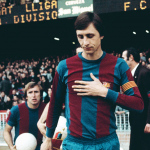
The most iconic in-house kits ever
A tradition shared by all football leagues around the world
March 8th, 2024
Every time our eyes fall on a football jersey, especially those from the major European and world leagues, we expect to see logos like the Swoosh of Nike, the Three Stripes of adidas, the diamond of Umbro, the initials of New Balance, or many others, like the puma of the eponymous brand, the runbird of Mizuno, or the overlapping arches of Under Armour. The partnerships that arise between football clubs and suppliers manage to delineate the visual identity of a company, marking, at least from an aesthetic point of view, entire football eras.
This is why since the news spread that Barcelona, after 26 years, will terminate its relationship with Nike, much speculation has been made about the successor to the Swoosh, although the most interesting scenario concerns the fact that the Blaugrana could produce the uniforms autonomously. It would be an unexpected leap into the past to the 1979/1980 season, a very brief period in which the club's kits were signed by Mont-Halt, a brand owned by Agustí Montal Costa, the president at the time. If it materializes, Barcelona's move would be almost revolutionary; a clear change in strategy born out of dissatisfaction with the amount Nike pays to the club, considered insufficient despite being around 150 million euros annually. The news in the coming days will provide further clarification on this situation; however, it is worth knowing that the practice of producing kits autonomously has been around for some time: there are many teams, especially from the late 1990s to the mid-2000s, that have refused - or simply not obtained - agreements with major brands, opting for in-house production of uniforms.
AS Roma 2013/2014
Some of the most iconic in-house uniforms of all time belong to the Giallorossi and are, at the same time, one of the most recent and particular examples to fall into this special category. There were no technical sponsors on Roma's jerseys that year because the ten-year contract signed with Nike - which had interrupted the sponsorship with Kappa - would start from the following season, which is why President James Pallotta did not bother to look for a technical sponsor for just one season. It was a special year for the Giallorossi, who also found themselves without a main sponsor. The equally iconic Wind disappeared in favor of Roma Cares, the charitable foundation promoted by the club. A unique jersey, not only because it was unbranded, but also for the design inspired by the Roman, one of the three teams from which the society we still know today was born.
Perugia 1995/1996
In-house kit or not? When it comes to self-produced kits, one of the most difficult stories to unravel is that of Galex. The brand was founded by Alessandro Gaucci, CEO of Perugia and son of the club's president, Luciano Gaucci, officially debuting on the team's jersey in that season, which had only recently ended its sponsorship with Ellesse. Galex will be established as a real lucky charm for the Umbrian club, which managed to leave behind the lower league and reach Serie A. However, despite bearing the Gaucci family name, Galex is not remembered exclusively for Perugia: over the years, it sponsored other Italian clubs, such as Catania, Ascoli, and finally Gallipoli in the 2006/2007 season.
Borussia Dortmund 2000/2001 - 2003/2004
Abandoning brands like PUMA, adidas, and Nike, can be a gamble. An example is that of Borussia Dortmund, which decided to start the twenty-first century competing with the aforementioned top suppliers, launching Goool.de. Goool.de was a subsidiary company of BVB, specializing in the production of sportswear items, from football to curling to hockey. Similar to Galex, despite being owned by the Westphalian club, it sponsored other clubs over the years: Victoria Köln and FC Dynamo Dresden. According to a report by the famous magazine Kicker, Goool.de generated profits of 110,000 euros in 2001, while it closed the 2005/2006 season with a loss of approximately 1.3 million euros, also due to the fact that Borussia Dortmund signed an agreement with Nike.
Southampton 1999/2000 - 2007/2008
In the maze of the web, you can find a myriad of photos of Gareth Bale's debut in the Premier League. The Welshman played for Southampton, and on the jersey he wore, you can see an S-shaped logo. The brand in question was Saints, founded by the club itself and considered an important chapter for the White and Reds' club identity. The supplier's name, in fact, refers to the most commonly used nickname for Southampton, "The Saints": that's why fans are used to singing the notes of the song When The Saints Go Marching In.
Real Betis Balompié 2009/2010 - 2011/2012
Moving to Spain, one of the most memorable examples is that of Real Betis Balompié, a club currently sponsored by Hummel which dreams of expanding in LaLiga by conquering Barcelona's jersey. The in-house kits of the Seville club demonstrate how these can turn into completely self-referential logos: on the uniforms used during that biennium, in fact, the acronym RBB appeared, referring precisely to the official name of the team. In short, the technical sponsor can sometimes turn into a real double logo.






















